https://doi.org/10.22214/ijraset.2023.49664

ISSN: 2321-9653; IC Value: 45.98; SJ Impact Factor: 7.538

Volume 11 Issue III Mar 2023- Available at www.ijraset.com

https://doi.org/10.22214/ijraset.2023.49664

ISSN: 2321-9653; IC Value: 45.98; SJ Impact Factor: 7.538

Volume 11 Issue III Mar 2023- Available at www.ijraset.com
Abstract: The excavator machines are power machines used in the Agricultural, Mining and Construction industry. The main purpose of this excavator is for digging, ground leveling and material transport operations etc. The excavator bucket part is subjected to various load forces. So in this project, the work is carried on the bucket by interchanging the composite materials like gray cast iron and vanadium. Since the bucket experienced so many loads like impact during digging transient analysis is carried out, the standard specimen prepared through stir casting technique and conducted tests on the specimen like tensile, compression, hardness, and impact test to validate the data. The main objective of this project is to design an excavator bucket using CATIA V5 software of 3-D modeling software. Then simulation did through ANSYS 19.2 software by transient analysis technique to know the deformation and stresses etc. And the results of deformation and stress are compared between Gray Cast Iron without Vanadium and Grey Cast Iron with Vanadium for comparing justified result.
Keyword: Excavator Bucket, Gray Cast Iron, Vanadium, Transient analysis, stir casting.
The main purpose of excavator machine is for digging the lands or mines, demolition, lifting heavy jobs etc. in this paper analysis carried out digging type excavator and optimized by interchanging the material. In this paper the material chosen for preparing specimen though stir casting technique. The composition of material is 99.5 % of grey cast and 0.5 % of vanadium to enhance the properties of bucket6 . The comparative study with the structural steel and ductile cast iron excavator buckets, which are the most commonly used for manufacturing processes for an excavator bucket. In addition, it was preferred to develop an optimized material which will decrease the weight of the component and enhance the properties. The following table indicates enchantment of properties by using vanadium for the bucket material. And also comparison between without addition of vanadium for material for manufacturing bucket 3 .
This is the procedure that can explain to determining the unknown parameters for the given excavator bucket as boundary conditions and solving the problem through transient analysis technique. The following procedure adopted to validate results5 The below flow chart describes the methodology to determining the problem in exiting design, drafting and analyzing the bucket, experimentation and comparison of results for validation.


ISSN: 2321-9653; IC Value: 45.98; SJ Impact Factor: 7.538

Volume 11 Issue III Mar 2023- Available at www.ijraset.com
For a digging type bucket there is impact force created on teeth of the bucket while digging, so in less duration of time large amount force applied on the teeth. In that case more stress is induced in the teeth part.
The bucket is subjected to various loads but generally failure occurs at the fixed position of the bucket and bushing and this will be at the centre of the bushing or at teeth end of excavator bucket. In such a condition the failure is due to maximum stresses acting when the bucket carries load and also while digging. So the stresses are applicable at the bushing and teeth portion
Stir casting is the method employed to prepare the specimens. Gray cast iron (ASTM 40) which has excellent casting performance and vanadium (99.5% & 0.5%) of weight to volume ratio have been taken into the consideration to prepare the specimen. Results show that the weight percentage of material exhibits better results1. The specimen was casted at 1204oC and at a stirring speed ranging in between 600-700 RPM for 15 minutes. Results implicate that the 0.5% inclusion of vanadium in raw grey cast iron has shown improvement of properties that are listed in the above table1. The standard specimen size mentioned below.
1) Tensile and Compressive Tests: A universal testing machine is use to conduct tensile and compression test conducted for given specimen showed in figure 1. And results listed below. The specimen fixed between two jaws of the UTM machine where load is increased gradually and readings are substituted in the given formula to determine maximum ultimate strength of the given specimen.
i) Tensile strength = ultimate load (P) / Area (A)

Where,
P = 133.831 KN
A = лd2/4 d=20mm = 314.159 mm2
Then, Tensile strength = 133.831/314.159 = 0.4259969 KN/ mm2 (or) 425.996 N/ mm2
ii) Compression strength = ultimate load (P) / Area (A)
Where,
P = 447.91 KN
A = лd2/4 d=20mm = 314.159 mm2

Then, Compression strength = 447.91/314.159 = 1.4257 KN/ mm2
A Brinell hardness testing machine is used to measure the hardness number for given specimen. An indentation is used to determine hardness using this machine and results explained below. Here ball diameter (d) of the indenter (D) and load applied on the specimen surface and values are substituted on given formula

ISSN: 2321-9653; IC Value: 45.98; SJ Impact Factor: 7.538
Volume 11 Issue III Mar 2023- Available at www.ijraset.com
BHN = 2P/πD(D - √(D2 - d2)) Where, Diameter of the indenter (D) =3 mm Load P = 876.8 Kgf

D = is the diameter of impression on the work piece = 1.7mm Then, Brinell hardness number = 2*(876.8) / π*(3)(3 - √(32 – 1.72)) = 1753.6/4.985 = 35.177
S.No Properties
By using above experiment results, the boundary conditions of given bucket can be applied in ANSYS workbench
Using CATIA V5 software modeling of excavator bucket done which is useful to export in .igs format to ANSYS v19.2 software for further preprocessing and determining stresses and deformations under various cases. The following figure.2 shows that 3D model of digging type bucket. The type of application is taken from standard paper1

ISSN: 2321-9653; IC Value: 45.98; SJ Impact Factor: 7.538

Volume 11 Issue III Mar 2023- Available at www.ijraset.com
The ANSYS 19.2 software is used to analyze bucket under various boundary conditions which is explained below. These are the results are obtained through the ANSYS software. The solution can be obtained by dividing into 3 cases

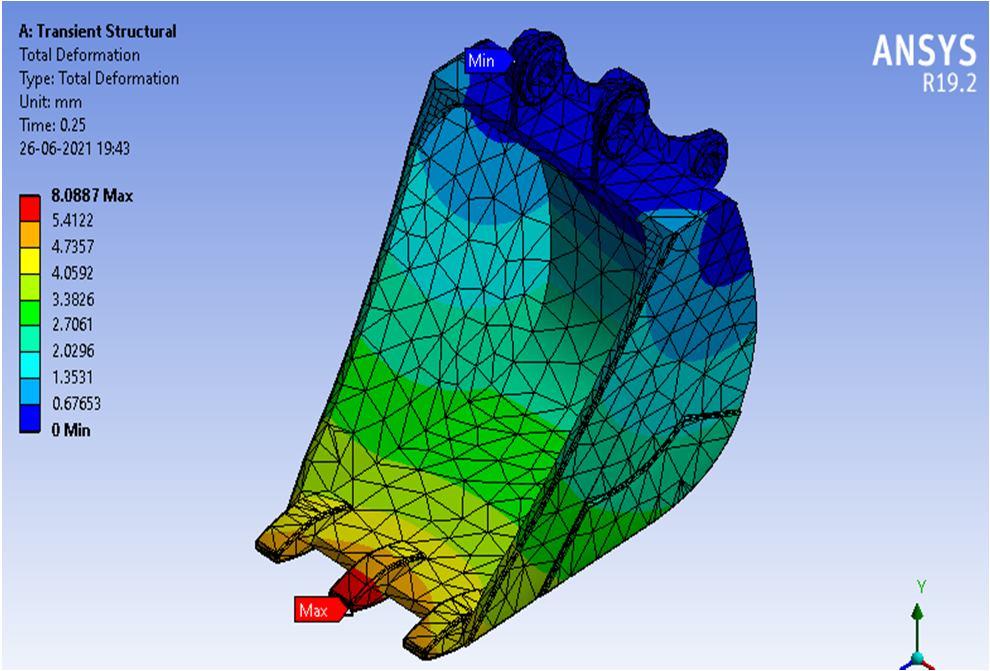
1) Case I: At 15696N (standard load) the results are obtained for Excavator bucket made of Gray Cast Iron without Vanadium and with Vanadium.
2) Case II: At 18000N load the results are obtained for Excavator bucket made of Gray Cast Iron without Vanadium and with Vanadium.
3) Case III: At 20000N load the results are obtained for Excavator bucket made of Gray Cast Iron without Vanadium and with Vanadium.
A. Case I

The following working conditions are considered to obtain ANSYS results. By placing the excavator bucket in standard load condition we can observe the following ANSYS results.
1) Gray Cast Iron
a) Total Deformation Plot.
The Maximum deformation observed is 8.0887 mm at 0.25 s at standard load (15696N).
b) Von Mises Stress Plot.
The Maximum Von-Mises stress observed is 1540.3 MPa at 0.25 s at standard load (15696N).
ISSN: 2321-9653; IC Value: 45.98; SJ Impact Factor: 7.538

Volume 11 Issue III Mar 2023- Available at www.ijraset.com
The Maximum Shear stress observed is 23.045 MPa at 0.25 s at standard load (15696N).
d) Maximum Principal Stress.
The Maximum principal stress observed is 63.178 MPa at 0.25 s at standard load (15696N).
a) Total Deformation Plot
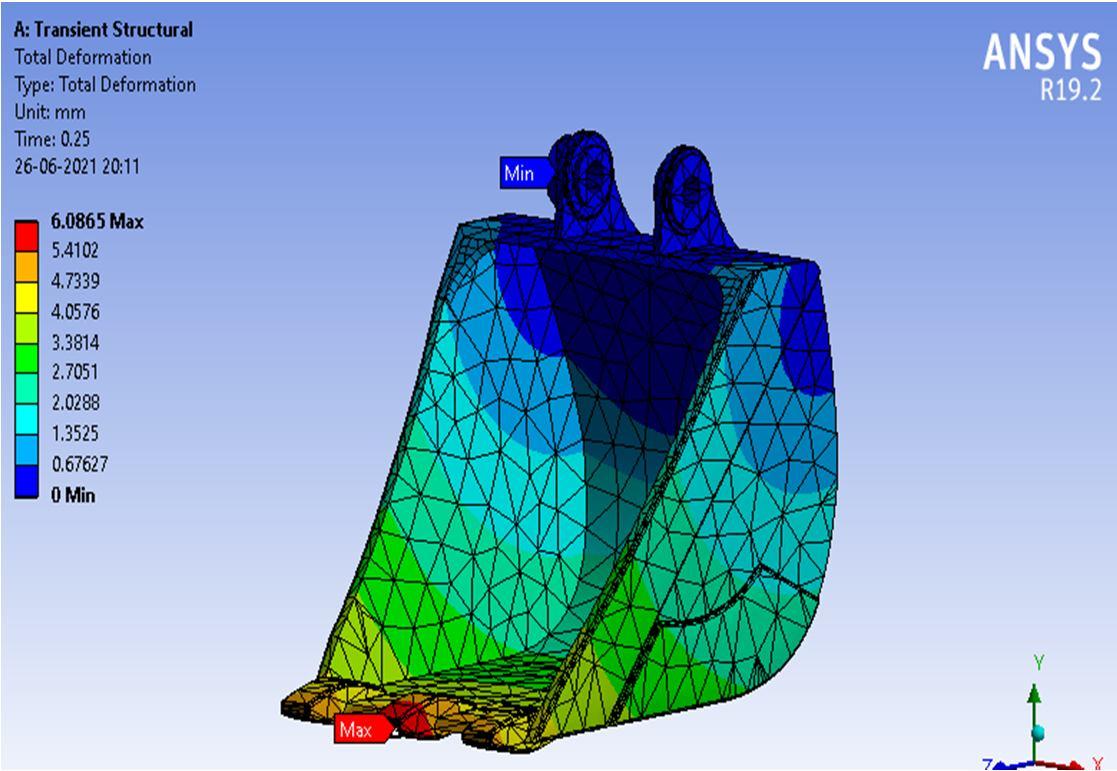


The Maximum deformation observed is 6.0865 mm at 0.25 s at standard load (15696N).

ISSN: 2321-9653; IC Value: 45.98; SJ Impact Factor: 7.538

Volume 11 Issue III Mar 2023- Available at www.ijraset.com
The Maximum Von-Mises stress observed is 147.97 MPa at 0.25 s at standard load (15696N).
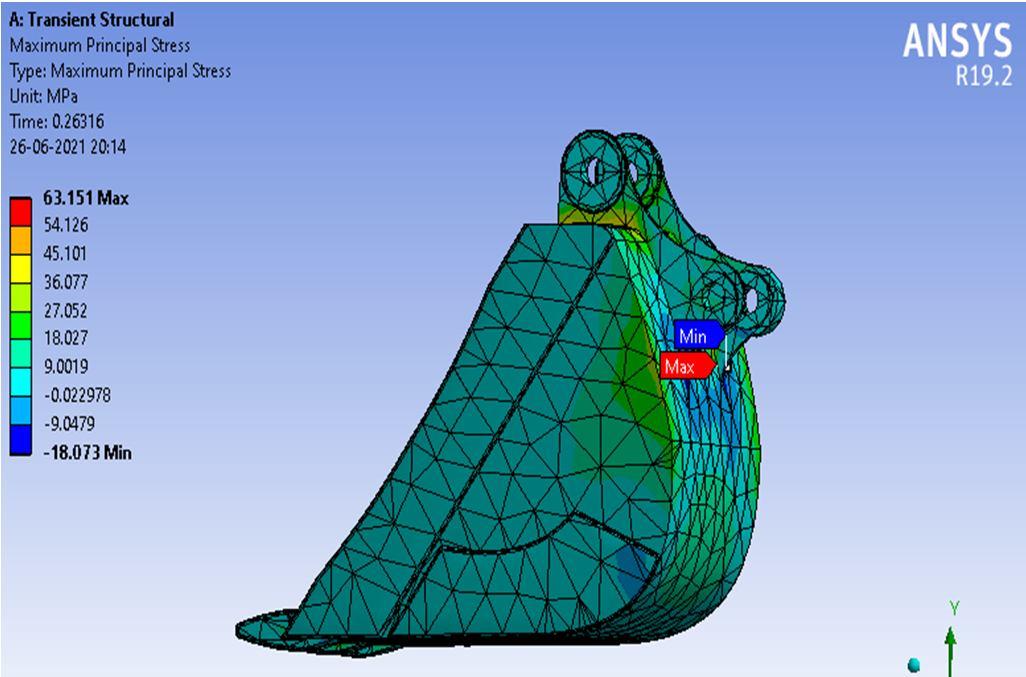
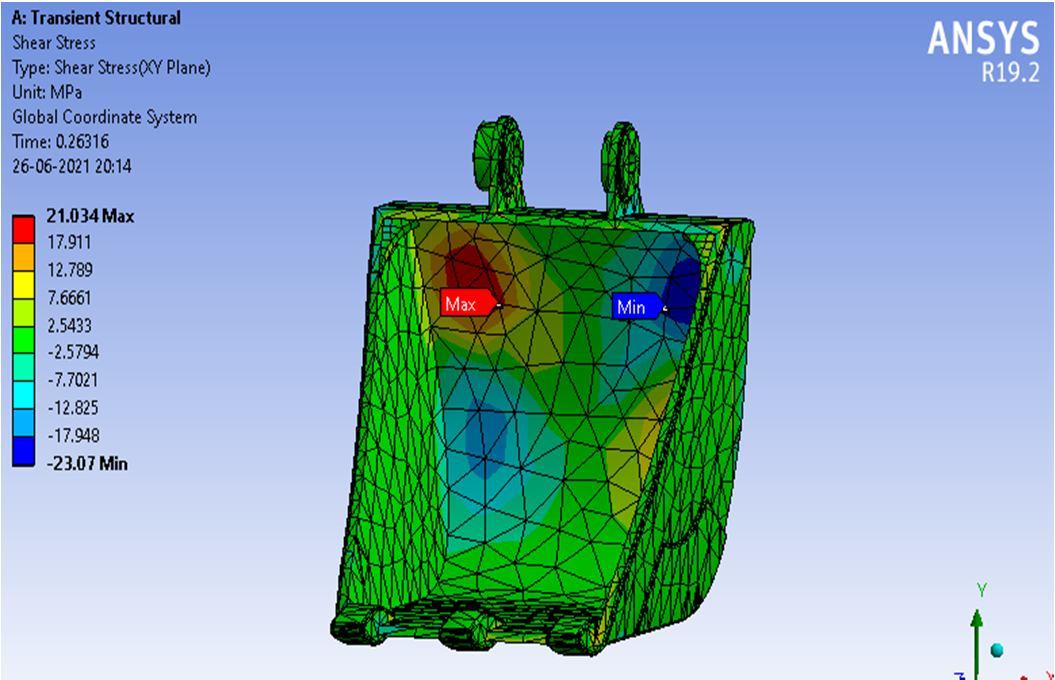

c) Shear Stress

The Maximum Shear stress observed is 21.034 MPa at 0.25 s at standard load (15696N).
d) Maximum Principal Stress
The Maximum principal stress observed is 63.178 MPa at 0.25 s at standard load (15696N)
Similarly other cases results are obtained and listed below table2.
ISSN: 2321-9653; IC Value: 45.98; SJ Impact Factor: 7.538

Volume 11 Issue III Mar 2023- Available at www.ijraset.com
At maximum loading condition, inclusion of vanadium improves the structural properties of composite material shown in below.
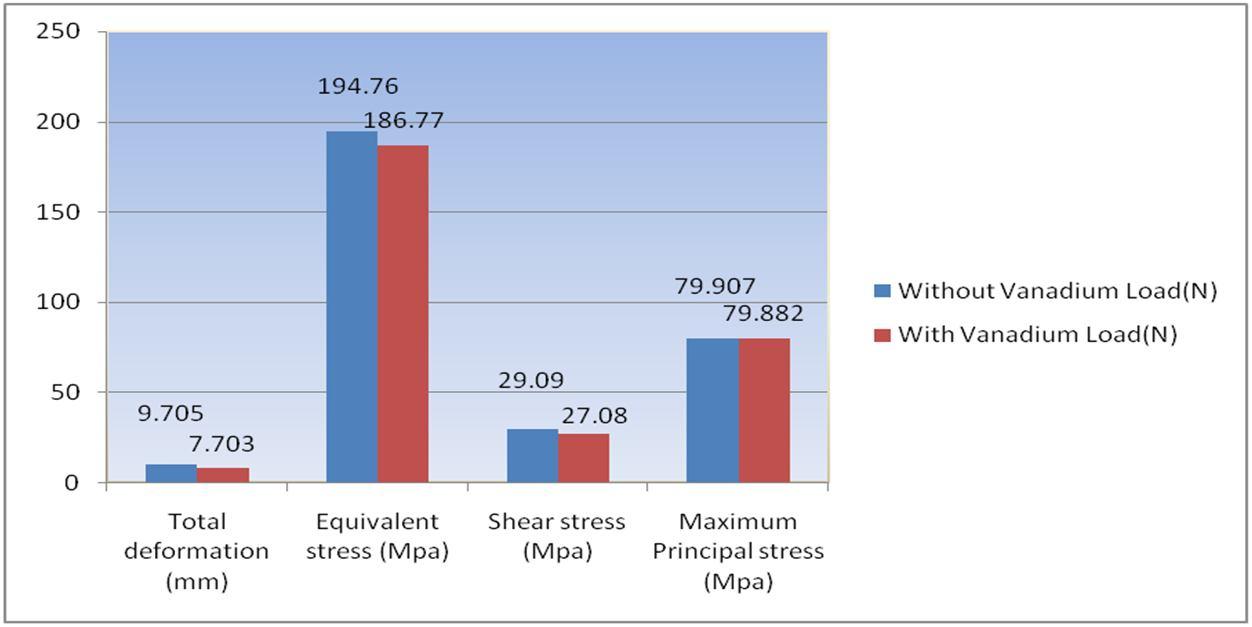
The following graph shows the results summary of the Case I, Case II and Case III. And also below graph 1, 2, 3 and 4 indicates the comparison between specimen alloy made with vanadium and without vanadium

By observing the above total deformation graph.1, we can see that the deformation of the Gray Cast Iron with Vanadium is less when compare with Gray Cast iron.

ISSN: 2321-9653; IC Value: 45.98; SJ Impact Factor: 7.538

Volume 11 Issue III Mar 2023- Available at www.ijraset.com

By observing the above Von Mises stress graph.2, we can see that the stress values of the Gray Cast Iron with Vanadium is less when compare with Gray Cast iron. Therefore Gray Cast Iron with Vanadium can carry more load the Gray Cast iron.
By observing the above Shear stress graph.3, we can see that the stress values of the Gray Cast Iron with Vanadium is less when compare with Gray Cast iron.

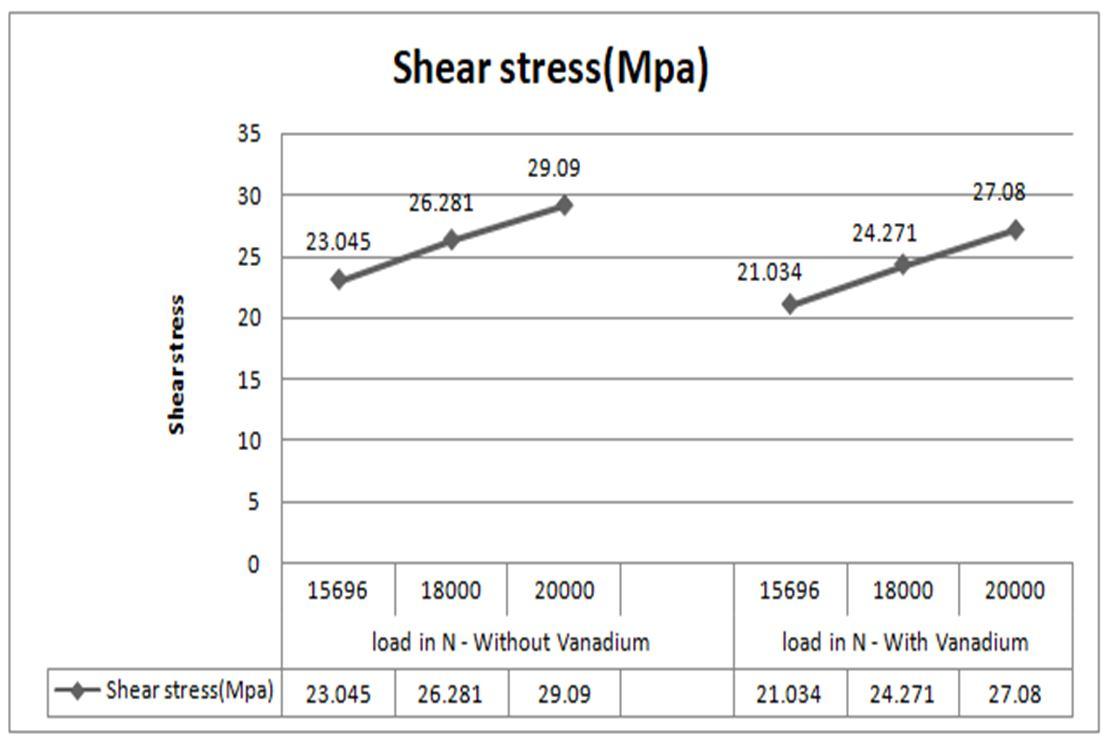

ISSN: 2321-9653; IC Value: 45.98; SJ Impact Factor: 7.538
Volume 11 Issue III Mar 2023- Available at www.ijraset.com
1) Experimental analysis is done on excavator bucket by comparing with and without inclusion of vanadium, under this conditions the behavior bucket is observed to know the critical loading conditions.
2) Under maximum loading condition, by the inclusion of vanadium in the material which improves the Total deformation, Equivalent stress, Shear stress, Maximum Principal stress compared with normal conditions.
3) Experimental testing like tensile test, compression test, impact test and hardness tests are done on the both materials i.e. Gray Cast Iron with Vanadium and Gray Cast Iron without Vanadium. In which we observed that Gray Cast Iron with Vanadium has better results than the Gray Cast Iron without Vanadium
4) We would like to conclude that at 15696N, 18000N, and 20000N load conditions will gives satisfactory results while choosing the Gray Cast Iron with vanadium as excavator bucket material while considering stress by maintain adequate structural strength and stability. And compare with Gray cast iron without vanadium results are very much satisfactory.
5) We would like to conclude also that at 15696N, 18000N, and 20000N load conditions will gives satisfactory results while choosing the Gray Cast Iron with vanadium as excavator bucket material while considering deformation factor. Gary cast iron with vanadium has less deformation then the normal gray cast iron.
6) By adding 0.5g of vanadium to the Gray cast iron we got 0.638% reduction in weight while comparing with Gray Cast Iron without Vanadium. Also the deformation or displacement by adding 0.5g of vanadium to the Gray Cast Iron, we got 14.124% reduction while compare with Gray Cast Iron without Vanadium at standard load condition.

[1] Akash V. Thombarer, Suved V. Dudhe, Snehal K. Wankhade, C. G. Deshmukh, Shape Optimization of an Excavator Bucket with the Help of ANSYS Software, International Research Journal of Engineering and Technology (IRJET), Volume: 08 Issue: 03 | Mar 2021
[2] K.Guna Sekhar & P.Dileep Kumar, Design and Analysis of an Excavator Bucket, International Journal & Magazine of Engineering, Technology, Management and research, ISSN No: 2348-4845, Vol 7, Issue 5, May 2017, pp 674-683
[3] Bhavesh Kumar. P. Patel & Dr. J.M. Prajapati, An excavation force calculations and applications: An Analytical Approach, International Journal of Engineering Science and technology, Vol 3, No. 5, May 2011, pp 3831-3837

[4] B. P. Patel, A Thesis on Design and Structural Optimization of Backhoe Attachment of Mini Hydraulic Excavator for Construction Work, Doctor of Philosophy, Shree Jagdishprasad Jhabarmal Tibrewala University, Rajasthan, 2012.
[5] Bhaveshkumar P. Patel, Jagdish M. Prajapati “Structural Optimization of Mini Hydraulic Backhoe Excavator Attachment Using Fea Approach” Machine Design, No.1, ISSN 1821-1259, Vol.5 2013.
[6] Ali Günen, Müge Kalkandelen, İsmail Hakkı Karahan & Bülent Kurt, Properties and Corrosion Behavior of Chromium and Vanadium Carbide Composite Coatings Produced on Ductile Cast Iron by Thermo reactive Diffusion Technique, Journal of Engineering Materials & Technology (JEMT), Volume 142, Issue 4, October 2020
